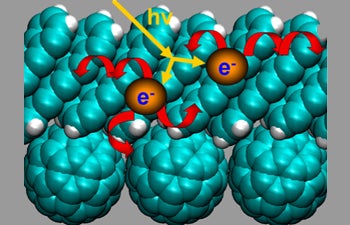An Energetic New Professor
Growing up in Kharkiv, Ukraine, Oleg Prezhdo loved mathematics, not unlike his mathematician mother. But ultimately, his physical organic chemist father encouraged him to pursue chemistry.
Prezhdo earned his Ph.D. in chemistry in the sunny climes of Austin, at the University of Texas. After a one-year postdoc position at Yale University, he progressed through the ranks of assistant, associate and full professor at the University of Washington in Seattle for 12 years before moving to Rochester, New York, where he served as professor of chemistry and physics at the University of Rochester.
He explained how he combined fields to focus his research on solar energy and nanotechnology.
“My research is solar energy-related, or energy-related in general. My background is somewhere between chemistry and physics,” Prezhdo said. “When I started my independent research career, I did a lot of fundamental research. I looked at how to combine quantum and classical dynamics and focused on non-equilibrium processes that happen very fast. The creation of solar energy is such a process because you take light, a photon, and you excite electrons, and generate positive and negative electrical charges very quickly.”
At the end of July, the theoretical chemist is moving his family 2,600 miles from Rochester to Los Angeles, where he has accepted a post at USC Dornsife as professor of chemistry. He is busy putting together his theoretical chemistry research lab.
“A number of my students are moving with me, and there’s a big incoming class in chemistry at USC this Fall, so we’ll pick up some students there, too,” he said. His lab will focus its research on finding new ways to produce more efficient solar energy.
“The goal is to make solar cells less expensive and more efficient, because that’s the main problem and the reason why they’re not used so much right now. We’re trying to use more affordable materials.”
A photovoltaic cell is an electrical device that converts the energy of light into electricity. Similarly, a photocatalytic cell converts solar energy into a chemical fuel. At present, most solar cells are made of silicon, competing with the electronics industry and making them costly.

Using a phenomenon known as “singlet fission” scientists are able to produce two electrons per one absorbed particle of light, improving solar cell efficiencies. Oleg Prezhdo studied this phenomenon in detail theoretically, providing guidelines on how to ensure that solar energy produces charges rather than being lost to heat. Graphic courtesy of Oleg Prezhdo.
Prezhdo explores the use of organic molecules and different oxides instead of silicon to convert solar light into electricity. He also works with graphene, a two-dimensional material just one carbon atom thick with many potential industrial applications. The discovery of graphene by two Russian-trained scientists, he noted, led to the 2010 Nobel Prize in Physics.
“Graphene is a metal, and usually people don’t use metals to absorb light and convert it to electricity, but we figured out how this could be done through chemical modifications.”
In an effort to develop new technologies, the various properties of different materials are studied to see what else they might be good for within the realms of solar energy, energy storage/batteries and nanobiology.
Prezhdo also looks at how liquids and certain molecules behave inside carbon nanotubes — CNTs — which are nanometer-sized cylinders of graphene.
“It turns out carbon nanotubes can be good for medical applications,” he said. “Lots of drug molecules are polar, so they cannot penetrate into cell membranes. Carbon nanotubes can puncture the membrane, and they can also take molecules inside the cell.
“One of our publications that made news showed that you can put drug molecules inside carbon nanotubes, deliver them into cells, then use a laser to shine light on the area where you want those molecules activated. The light penetrates the skin and the molecules are released from the carbon nanotubes.”
This methodology, and the ability to deliver drugs directly to targeted cells and tissues, has potential biomedical applications for the diagnosis and treatment of cancer.
With his interest in the fundamental aspects of dynamics and processes that happen in a very fast time frame, he began to think about practical applications of the research, such as technology or inventions.
“The whole system in the U.S. makes you think more, in a good way, about applications.”
One option was solar energy.
“This was before solar energy became very popular. I started around 2000, just because it was an interesting application.”
Prezhdo is looking forward to joining the ranks of the chemistry department at USC Dornsife, noting its strength in theoretical chemistry.
“Including me there will be five theorists, which is rare,” he said. “Of course [Distinguished Professor of Chemistry] Arieh Warshel just won the Nobel Prize, which makes that area of the department even stronger. I will also be connected with researchers doing vigorous work in this area.”
He noted Professor of Chemistry Anna Krylov’s work on recurring structure theory and electronic properties of systems as well as the larger-scale work being done by Warshel and Chair and Professor of Chemistry Chi Mak.
“I will be in excellent company,” he said.